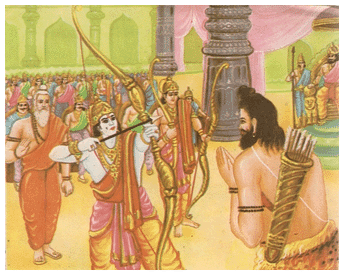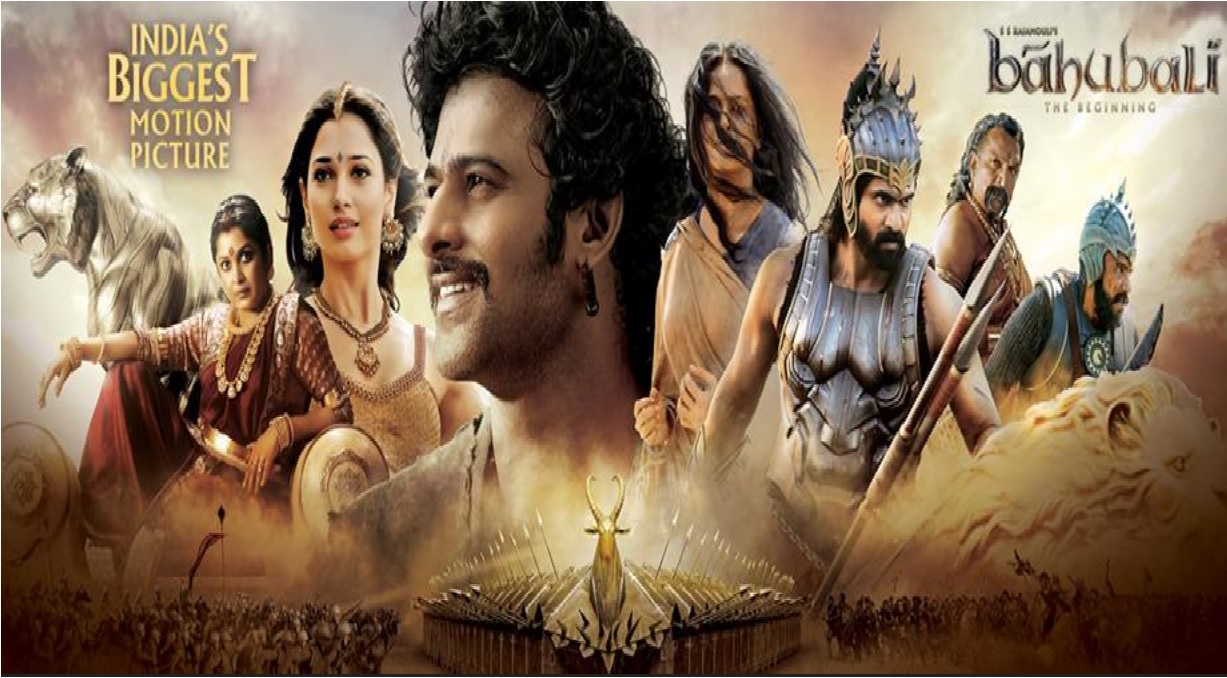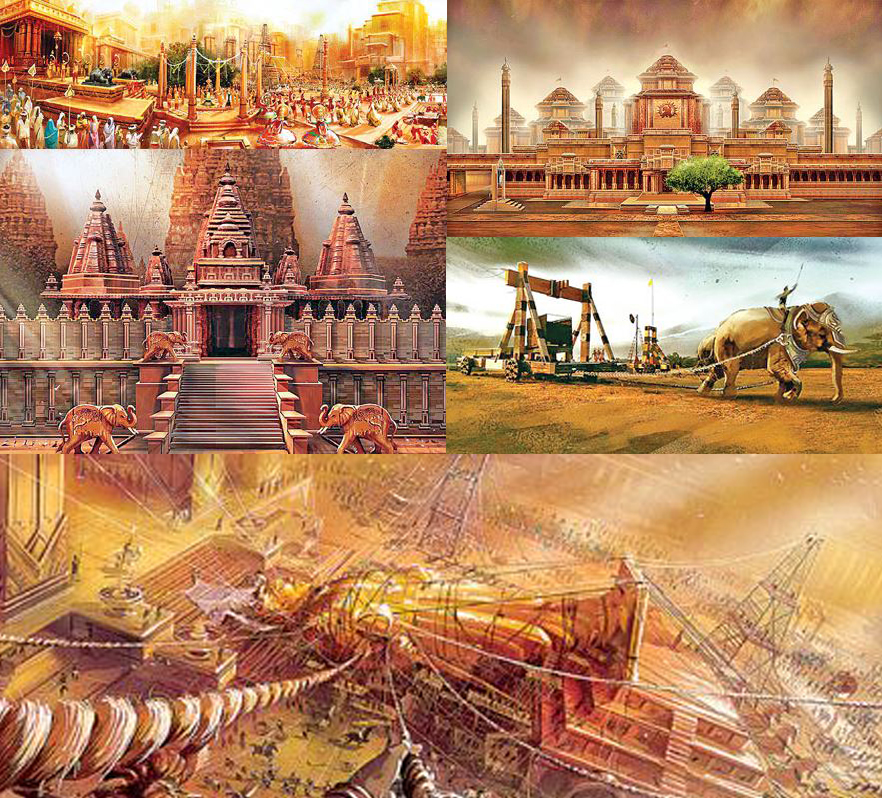A version of this Post was published at Andhra Cultural Portal, on July 22, 2015
Much water has flowed down the waterfall south of Mahishmati since we last touched on this topic. Those of you following us on Andhra Cultural Portal would have read our Post 2 years ago when Baahubali-The Beginning was released. Well, unless you were living in one of those caves featured in the film, you would not only be familiar with this phenomenon, but also would have watched it…several times.
And make no mistake, this Andhra movies is not just a national or global phenomenon, but especially a civilizational one for all members of Indic Civilization. It is not for nothing this Telugu language movie was a hit in Nepal. Part 2’s distribution rights have already sold for 3 crores in Prithvi Narayan Sah‘s Hindu Rajya.
You would also have heard the new trailer was one of the fastest to garner 100 million views on YouTube. Wondering why? — see for yourself!
So in honour of Srisaila Sri Rajamouli’s digital age epic’s second installment, Baahubali 2-The Conclusion, we give a reprint of our review of Part 1. Enjoy. Watch the movie. And above all…
Jai Mahishmati!
The scores are in, the box office has reported, and the people have spoken: Baahubali-The Beginning is a box office behemoth. S.S. Rajamouli’s smash hit is truly a magnum opus that has swept all of India, South and North of the Vindhya. Indeed, much ink has already marked the proverbial paper, and a number of columns, cookie cutter top tens, and well-penned essays have made their mark. What’s more, long derided regional Telugu cinema is no longer seen as merely a source for remakes, but as even foreigners note, is a source of jealousy for Bollywood insiders. As Krishnarjun gaaru has written, the industry itself has the potential to go back to its golden age 3-5 decades ago, with classics such as Maya Bazaar and Missamma.
Nevertheless, while ACP typically analyzes movies long after the glitz and glamour of a premiere has passed, there is something special about this film that has come to underscore the present zeitgeist. As such, this post is not our standard cinematic analysis, or a fine study of symbology, or even a well-crafted commentary on the industry’s future. Rather it is about understanding the cultural resonance of Baahubali and why it’s relevant and indeed a revelation at this place and at this time. We have sought to do this with ** No Spoilers** for those of you who have yet to see it.
First, a Rejoinder
Despite all the acclaim— not only in the Telugu rashtras or even just Bharata desa, but also globally—sour grapes from the standard set has been increasing from dribble to a deluge. The bitter wine they swill is in the hopes of poisoning the popular opinion. As such, a rejoinder is in order.
Almost two weeks in, the knives are now out courtesy the usual suspects: “Idea of India” indoctrinues (copyright pending for portmanteau), Dubai-gang ghulams of bollywood, and assorted sordid-sickulars of all sorts are now slashing at this movie, after a proverbial puissant punch to the solar plexus. Gasping for breath, these pill-popping, phillim-hopping philistines have the gall to tear down this movie by hook or by crook. The “un-original” charges (Tarzan this, Lord of the Rings that) are particularly asinine, especially coming from bollywood. After all, Ramesh Sippy’s Sholay drew from Sergio Leone’s Once Upon a Time in the West, which drew from John Sturges’ The Magnificent Seven, which ultimately drew from Akira Kurosawa’s Seven Samurai. It’s invariable that inspiration here and there may come from different sources–the question is breathing new life, new vision, and new context into them, and weaving them into a unique piece. Baahubali has accomplished this to the shame of Bollywood.
As these intellectual imps impotently shriek and wailed “animal film!”, “symbolic molestation!”, “misogyny!”, they tried every trick in the book, first saying they “don’t review south movies”—but hey check out this no name flick from our sworn enemy), then they ridiculed looks or even the very idea of a big hit “from south”, finally they began throwing mud through specious Freudian analyses and crackpot conclusions about tribal relations. In short:
First they ignore you, then they laugh at you, then they fight you, then you win.
Setting aside their ignorance about the Kalakeyas in the Mahabharata (yet another example of what happens when you don’t know your own epics), the question isn’t whether Bharatvarsha, the land of Rama’s friend Guha, Pratap’s friends among the Bhils, or Rani Durgavati’s own in-laws, treated its tribals well, but what happened to the tribes of Europe? Bharat respected the tribal way of life, and even saw its merits by encouraging vana prastha (forest life) for retired kings and other elites.
In any event, the body blow from Baahubali had left them in a week-long stupor that they are only now gurgling back from. Left with little other than Bajrangi Bhaijan to salve their wounds, they have united around this flick touting everything from “sentiment & emotion!” to “profitability” (a.k.a. the Sonam Kapoor defence)—poor dears. And yet, why this movie and why such mendacity? After all, Magadheera showed a native Bharatiya kingdom in a complimentary fashion. It too balanced CGI and Story with dramatic action and theatric performances. Those who point to a display of Hinduism (Sanatana Dharma) in positive light, forget the Kala Bhairava Statue that served as the sentinel of cinematic climax. No, the reason why Bahubaali-The Beginning, this movie, at this time, has stirred up a hornet’s nest of hate, is because it is true cinematic splendour celebrating Dharma.
Despite the laughable claims about Bajrangi Bhaijan touting an emotive ideal, while Baahubali did not, it’s quite clear that this movie was refulgent with an ideal. Dharma, in all its myriad forms, in all its numerous nuances, is immanent throughout this Sistine chapel in celluloid. And unlike that metaphor, the fact that Rajamouli’s Masterpiece drew on native Indic forms (architecture harkens to Angkor, Amaravati, and Avanti) , native Indic fashion (Tamannah’s transformative couture is more the ancient standard), Indic names (Avantika, Baahubali), Indic Sacred History (Rishabhadeva’s sons are an overarching influence), and Indic Geography (Mahismati was the capital of Kartaveerya Arjuna), only roiled our stealth regressive royyalu (that’s Telugu for “shrimp”, btw) further. That it was able to do this by bringing Bharatiyas of all panths (religions) in to enjoy the ride and make them feel a part of the experience, was the last straw.
Dharmic Culture
In a way, it’s almost poetic that a movie so redolent in Dharma Culture was distributed and promoted by Karan Johar’s Dharma Productions. Though obviously written, produced, directed, and lead acted by Telugus, this multi-starrer provided a tale and experience to which all Bharatiyas could relate.
We saw a dharmic society in action. From artistry and architecture to the traditional sastras and functioning of statecraft, it was an image of an India that once was. True, it was balanced by elements of fantasy and drew directly from the Puranas, via the Kalakeyas. But we also a saw a version of how our ancestors lived and the principles that drove them: patriotism, loyalty, self-sacrifice, motherhood, love, and above all Dharma.
What’s more, it was an image of not just how the elites might have lived, but the commoners as well. We see how villagers and elites coexisted honorably. Albeit underneath a fantastic and fantastical waterfall, it was a portrait nonetheless of the idylls of rural and even forest life. It too was replete with Dharma—not the philosophical or intellectual dharma, but the everyday dharma, the common dharma. Society may have different classes, but if the elites behave properly and with humility and a sense of social duty, then society is at harmony. The Brahmanas we see on film present a living memory of such great yet humble men.
In a snub to faux animal welfare activists (who think eating fish is inhumane, but are miraculously pro-beef), a version of Jallikattu is presented as a martial pass time. What’s more we even see an internal rebuttal regarding animal sacrifice. A Right hand Tantra riposte of the Left hand is given, demonstrating that Dharma offers alternatives internally to such practices in the name of Kulachara.
We see shakti in action, with numerous strong roles played by numerous strong women. Rather than being mere chattel, our women, our queens, commanded respect, and Shakti balanced her counterpart. We see glimpses of love and even a version of Gandharva Vivaha, where lovers came together through choice. Rather than merely loving and leaving, it was union of souls. That it was indeed marriage was emblematic when the obligation of the girl also become the obligation of the boy. As such, more than anything else, it was duty, and in particular, Kshatriya duty, that truly made its mark on screen.
The Kshatriya Ideal
Magadheera was certainly a cinematic benchmark, but Baahubali is a cultural phenomenon. The title role is not a common soldier, but a Kshatriya incarnate. As ‘The One with Strong Arms‘ he fights not only with his weapons and fists, but also with his wits. Indeed, we see that the true Kshatriya, the true King, is the one who protects his people and has their interests at heart. What’s more, this embodiment of Kshatriyata was not merely limited to men. We see a true Kshatrani in action, in conjunction with many strong and even warrior women. Ramya Krishnan alone deserves applause for her compelling and moving performance. In many ways it is she who presents the fulcrum of the film. Not only checking ambition within herself and her own family, she asserts that the true Kshatriya is not a usurper, but executes his duty to the ruling house loyally. Indeed, she provides a firm feminine rebuke to pig-headed male ambition.
The great Kshatriya vamsas of old not only had great power but expectations of great responsibility. The Kshatriya ideal of balancing education, training, statecraft, wealth, and power is the need of the hour. Rote-memorisation and blind application of and training in the sastras will not win the Kurukshetra. It is for this reason that adhyatmik and laukik knowledge were separated. Adhyatmik vidya is verily the soul of our tradition. But due to the high minded principles it inspires, it requires protection from evil via laukika vidya.
Therefore, Kshatriyas were the natural leaders of society. They had an understanding of and respect for the adhyatmik principles, but the pragmatism to recognize the era of falsehood that we live in, and the improvisation it requires. Hence, the true Kshatriya is not a hot-blooded, hot-head who loses his temper in blind anger, but is a strong willed defender of truth, by whatever means necessary. Varnashrama dharma certainly has degenerated in the past millennium into arrogant and brainless casteism from all ranks, and surely has its issues, but when properly conceived, it is one of balance. A society with an over-sized head, cannot be supported by the rest of its body. The true brahmanas of yore understood that as the teachers and philosophers of society, material living was not for them, and neither sought power nor wealth nor demanded sycophancy or undue influence. The true brahmana after all, is without ego. They also understood the limits of the brahmana varna, and as Parashurama corrected the imbalance of Kshatriyas crossing their limits, so too did Bhagavan Rama correct it with Ravana, and ironically, Parashurama himself.

The traditional partnership of Kshatriyas and Brahmanas is today mired in predation or pretentiousness. Those who aspire to those ideals must remember that Maharishi Veda Vyasa’s own son, the brahmana Suka deva, completed his education under the Rajarishi Janaka. Thus, while Kshatriyas were the natural political leaders and brahmanas the natural spiritual leaders, both required elements of the other to properly conduct their duties.
Competence is not mere aptitude or ability. After all, potential energy exists even in still water. Competence is being good at what you do. Ability too has varying degrees, but competence means you have sufficient ability for the job—not merely on the basis of natural talent, or studies, or even training, but due to habit of improvisation and adaptation confirmed through practical experience.
The sastras afford us with guidance, but it is the job of the general, the job of the Raja to not only learn and understand knowledge, but apply and improvise it. This is not done in the gurukul or ashram, but on the battle map or field of battle. After all, the tactics used by Chhatrapati Shivaji were evolved by Maharana Pratap—who had no Samarth Ramdas.

Therefore, leadership in society requires balance. Of the spiritual with the practical, of the traditional with the necessary, of the brahmana with the kshatriya. That this movie was able to present the kshatriya spirit, the aristocratic ethos, without ridiculing Adarsh liberal’s favourite punching bag—Brahmins—is only fuel for the fire of indigestion they’ve been suffering since July 10th. That is what Baahubali presented—and oh so very artistically at that. Whether it was the One with Thousand Arms or the One with Strong Arms, Mahishmati was the Capital of Kings.
Artistic Highlights
From its waterfalls to its mountains to its maps, this film is pure artistic splendour. The cinematography is truly outstanding and world-beating, and all elements of cinema—from the visual and auditory to the dramatic and literary—are in sound balance. A complete movie, it serves as a grand canvas for not only fantasy, but indeed, on-screen poetry.
One of the more interesting aspects wasn’t the research into our Puranas or even the dress and architecture of the ancients, but the subtle inclusion of our classical literature’s approach to drama. Though perhaps not noticeable to our non-Andhra friends, the dialogue features different forms of Telugu, based on orders of society—a practice commonly used by the ancients. Thus, we see literary forms of the language ( granthikam ), along with dialectical ( mandalikam ) and colloquial ( janapadam ).
We are also given a vision of fashion and femininity that is nevertheless strong and full of Shakti. Traditional designs and forms are presented in a manner that is sensuous but not titillating.

Even rati bhava is treated with delicacy in a restrained manner. The artificial is blended with the natural, rather than challenging it. It is not the conquest of nature by man, but the harmony of man and woman with nature.
In short, this movie is a marriage of tradition and tastefulness, form and function, masculine and feminine, elite and common, ancient and modern, art and technology.
Inflection point for the Industry?
Long time readers may recall our early pieces on the Telugu film industry (tollywood no longer) bemoaning the state of the sector. Ironically, one of them actually touched on film and kshatriyata. Rather than being merely seen as an object for derision, it has an opportunity again to rise to its early heights in the 50s and 60s. From kitsch, are we truly seeing a return to art? One hopes that the smashing success of the film will ensure at least a few movies that at least aspire to such a level, even if they do not scale such Himalayan heights. The upcoming release of Rudhramadevi affords an opportunity. Indeed, Baahubali served as an exquisite launch vehicle for Anushka Shetty to a national audience. Whether Gunasekhar is ultimately able to balance CGI with cinematic depth and action with taste, remains to be seen. We remain hopeful.
A Riposte to the “Idea of India” & The Breakthrough of Bharat
This movie was nothing short of a riposte to the ineluctable “Idea of India”—hence its resonance with all classes. This colossus of a success has shown that cheap laughs, titillation and tawdriness, and the apotheosis of all things non-native, no longer need be the way to box office success, or more importantly, cinema and culture.
Above all, was the sense of belonging to a common society that truly resonated. This wasn’t just a Telugu movie about Telangana or Andhra Pradesh, but an Indian movie about India. The India that once was. What’s more, rather than attempting to pass for Persians or Syrians, the lead actor looked like he might actually be one of them—Indians. Full credit to Prabhas for the physique he developed to give a vision of a royal hero that actually looked like the people—a reality underscored by his own real life pedigree. Rana brought the glamour, but the heart and soul of kingship was played by the first lead.
Indeed, our brothers and sisters in the North have long been deprived of cultural expression of native high culture courtesy Bollywood. They have been taught and even expected to see themselves as part of that spectrum rather than the subcontinent’s as a whole. This movie changed all that. Perhaps nothing emphasised that more when Katappa’s native Indic khadga smashed the prized Persian sword. This scene was fitting not only in an artistic rejoinder to the Idea of India brigade, but in an historical and technological one as well. The famed wootz steel (ukku) ingots of India were what made the finest blades of the era. Indeed, the historical Andhra desa was distinguished for its khandas, and made the Kakatiya kingdom all the more splendrous.
Make no mistake, this was an original movie. Ostensibly, the fairy tale jibes will lead to the obvious Lord of the Rings, Tolkien comparisons. After all, suited simulacra can never see anything beyond the western. But what these indoctrinated ingénues forget was that Tolkien himself drew on Norse and biblical mythology to create one for the English. S.S. Rajamouli had no such need. He was able to draw on the incredible fountain of Classical Indic Literature, with all its epics, sophistication, beauty, and nava rasas, and use his talent, vision, and entrepreneurial courage, to bring them to life and make them relevant to the times. So let the pop-psychologists, Freudian hacks, Lutyens insiders, foreign sympathisers, and serial slanderers run their ignorant mouths…We, the native public, the real public, know the real reason behind The Civilizational Resonance of Baahubali.
Predictably ignorant of the native Literary canon, serial rudaali, PK pablum peddler, and apochryphal activist Aamir Khan is said to have remarked after watching Inception “we [Bollywood] can’t even think at that level [Hollywood]”. Perhaps Bollywood can’t think at that level, PK, but Bahubaali has shown that Bharatiyas—real Bharatiyas—certainly can.
Jai Mahishmati!
References:
- http://www.thehindu.com/news/cities/Visakhapatnam/telugu-scholars-see-need-for-comprehensive-dictionary/article7121325.ece







